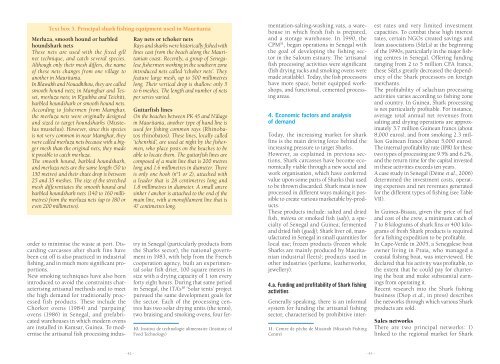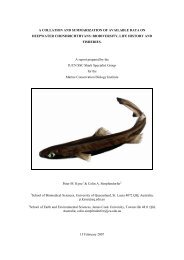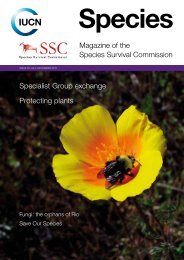30 Years of shark fishing in west africa - Shark Specialist Group
30 Years of shark fishing in west africa - Shark Specialist Group
30 Years of shark fishing in west africa - Shark Specialist Group
You also want an ePaper? Increase the reach of your titles
YUMPU automatically turns print PDFs into web optimized ePapers that Google loves.
Text box 5. Pr<strong>in</strong>cipal <strong>shark</strong> <strong>fish<strong>in</strong>g</strong> equipment used <strong>in</strong> Mauritania<br />
Merluza, smooth hound or barbled<br />
hound<strong>shark</strong> nets<br />
These nets are used with the fixed gill<br />
net technique, and catch several species.<br />
Although only their mesh differs, the name<br />
<strong>of</strong> these nets changes from one village to<br />
another <strong>in</strong> Mauritania.<br />
In Blawakh and Nouadhihou, they are called<br />
smooth hound nets; <strong>in</strong> Mamghar and Tesset,<br />
merluza nets; <strong>in</strong> R’guibba and Teichitt,<br />
barbled hound<strong>shark</strong> or smooth hound nets.<br />
Accord<strong>in</strong>g to fishermen from Mamghar,<br />
the merluza nets were orig<strong>in</strong>ally designed<br />
and sized to target hound<strong>shark</strong>s (Mustelus<br />
mustelus). However, s<strong>in</strong>ce this species<br />
is not very common <strong>in</strong> near Mamghar, they<br />
were called merluza nets because with a bigger<br />
mesh than the orig<strong>in</strong>al nets, they made<br />
it possible to catch merluza.<br />
The smooth hound, barbled hound<strong>shark</strong>,<br />
and merluza nets are the same length (50 to<br />
150 metres) and their chute drop is between<br />
25 and 35 meshes. The size <strong>of</strong> the stretched<br />
mesh differentiates the smooth hound and<br />
barbled hound<strong>shark</strong> nets (140 to 160 millimetres)<br />
from the merluza nets (up to 180 or<br />
even 200 millimetres).<br />
Ray nets or tchoker nets<br />
Rays and <strong>shark</strong>s were historically fished with<br />
l<strong>in</strong>es cast from the beach along the Mauritanian<br />
coast. Recently, a group <strong>of</strong> Senegalese<br />
fishermen work<strong>in</strong>g <strong>in</strong> the southern zone<br />
<strong>in</strong>troduced nets called ‘tchoker nets’. They<br />
feature large mesh, up to 500 millimetres<br />
long. Their vertical drop is shallow: only 5<br />
to 6 meshes. The length and number <strong>of</strong> nets<br />
per series varied.<br />
Guitarfish l<strong>in</strong>es<br />
On the beaches between PK 45 and N’diago<br />
<strong>in</strong> Mauritania, another type <strong>of</strong> hand l<strong>in</strong>e is<br />
used for <strong>fish<strong>in</strong>g</strong> common rays (Rh<strong>in</strong>obatos<br />
rh<strong>in</strong>obatos). These l<strong>in</strong>es, locally called<br />
‘tchenrkid’, are used at night by the fishermen,<br />
who place posts on the beaches to be<br />
able to locate them. The guitarfish l<strong>in</strong>es are<br />
composed <strong>of</strong> a ma<strong>in</strong> l<strong>in</strong>e that is 200 metres<br />
long and 1.6 millimetres <strong>in</strong> diameter. There<br />
is only one hook (n°1 or 2), attached with<br />
a leader that is 28 centimetres long and<br />
1.8 millimetres <strong>in</strong> diameter. A small ancre<br />
s<strong>in</strong>ker / anchor is attached to the end <strong>of</strong> the<br />
ma<strong>in</strong> l<strong>in</strong>e, with a mon<strong>of</strong>ilament l<strong>in</strong>e that is<br />
47 centimetres long.<br />
order to m<strong>in</strong>imise the waste at port. Discard<strong>in</strong>g<br />
carcasses after <strong>shark</strong> f<strong>in</strong>s have<br />
been cut <strong>of</strong>f is also practiced <strong>in</strong> <strong>in</strong>dustrial<br />
<strong>fish<strong>in</strong>g</strong>, and <strong>in</strong> much more significant proportions.<br />
New smok<strong>in</strong>g techniques have also been<br />
<strong>in</strong>troduced to avoid the constra<strong>in</strong>ts characteris<strong>in</strong>g<br />
artisanal methods and to meet<br />
the high demand for traditionally processed<br />
fish products. These <strong>in</strong>clude the<br />
Chorkor ovens (1984) and ‘parpa<strong>in</strong>g’<br />
ovens (1986) <strong>in</strong> Senegal, and prefabricated<br />
warehouses <strong>in</strong> which modern ovens<br />
are <strong>in</strong>stalled <strong>in</strong> Kamsar, Gu<strong>in</strong>ea. To modernise<br />
the artisanal fish process<strong>in</strong>g <strong>in</strong>dustry<br />
<strong>in</strong> Senegal (particularly products from<br />
the <strong>Shark</strong>s sector), the national government<br />
<strong>in</strong> 1983, with help from the French<br />
cooperation agency, built an experimental<br />
solar fish drier, 100 square meters <strong>in</strong><br />
size with a dry<strong>in</strong>g capacity <strong>of</strong> 1 ton every<br />
forty eight hours. Dur<strong>in</strong>g that same period<br />
<strong>in</strong> Senegal, the ITA’s 10 ‘Solar tents’ project<br />
pursued the same development goals for<br />
the sector. Each <strong>of</strong> the process<strong>in</strong>g centres<br />
has two solar dry<strong>in</strong>g units (the tents),<br />
two brais<strong>in</strong>g and smok<strong>in</strong>g ovens, four fer-<br />
10. Institut de technologie alimentaire (Institute <strong>of</strong><br />
Food Technology)<br />
mentation-salt<strong>in</strong>g-wash<strong>in</strong>g vats, a warehouse<br />
<strong>in</strong> which fresh fish is prepared,<br />
and a storage warehouse. In 1990, the<br />
CPM 11 , began operations <strong>in</strong> Senegal with<br />
the goal <strong>of</strong> develop<strong>in</strong>g the <strong>fish<strong>in</strong>g</strong> sector<br />
<strong>in</strong> the Saloum estuary. The ‘artisanal<br />
fish process<strong>in</strong>g’ activities were significant<br />
(fish dry<strong>in</strong>g racks and smok<strong>in</strong>g ovens were<br />
made available). Today, the fish processors<br />
have more space, better equipped workshops,<br />
and functional, cemented process<strong>in</strong>g<br />
areas.<br />
4. Economic factors and analysis<br />
<strong>of</strong> demand<br />
Today, the <strong>in</strong>creas<strong>in</strong>g market for <strong>shark</strong><br />
f<strong>in</strong>s is the ma<strong>in</strong> driv<strong>in</strong>g force beh<strong>in</strong>d the<br />
<strong>in</strong>creas<strong>in</strong>g pressure to target <strong>Shark</strong>s.<br />
However, as expla<strong>in</strong>ed <strong>in</strong> previous sections,<br />
<strong>Shark</strong> carcasses have become economically<br />
viable through a new social and<br />
work organisation, which have conferred<br />
value upon some parts <strong>of</strong> <strong>Shark</strong>s that used<br />
to be thrown discarded. <strong>Shark</strong> meat is now<br />
processed <strong>in</strong> different ways mak<strong>in</strong>g it possible<br />
to create various marketable by-products.<br />
These products <strong>in</strong>clude: salted and dried<br />
fish, métora or smoked fish (saly), a specialty<br />
<strong>of</strong> Senegal and Gu<strong>in</strong>ea; fermented<br />
and dried fish (guedj); <strong>Shark</strong> liver oil, manufactured<br />
<strong>in</strong> Senegal <strong>in</strong> small quantities for<br />
local use; frozen products (frozen whole<br />
<strong>Shark</strong>s are ma<strong>in</strong>ly produced by Mauritanian<br />
<strong>in</strong>dustrial fleets); products used <strong>in</strong><br />
other <strong>in</strong>dustries (perfume, leatherworks,<br />
jewellery).<br />
4.a. Fund<strong>in</strong>g and pr<strong>of</strong>itability <strong>of</strong> <strong>Shark</strong> <strong>fish<strong>in</strong>g</strong><br />
activities<br />
Generally speak<strong>in</strong>g, there is an <strong>in</strong>formal<br />
system for fund<strong>in</strong>g the artisanal <strong>fish<strong>in</strong>g</strong><br />
sector, characterised by prohibitive <strong>in</strong>ter-<br />
11. Centre de pêche de Missirah (Missirah Fish<strong>in</strong>g<br />
Centre)<br />
est rates and very limited <strong>in</strong>vestment<br />
capacities. To combat these high <strong>in</strong>terest<br />
rates, certa<strong>in</strong> NGOs created sav<strong>in</strong>gs and<br />
loan associations (S&Ls) at the beg<strong>in</strong>n<strong>in</strong>g<br />
<strong>of</strong> the 1990s, particularly <strong>in</strong> the major <strong>fish<strong>in</strong>g</strong><br />
centres <strong>in</strong> Senegal. Offer<strong>in</strong>g fund<strong>in</strong>g<br />
rang<strong>in</strong>g from 2 to 5 million CFA francs,<br />
these S&Ls greatly decreased the dependency<br />
<strong>of</strong> the <strong>Shark</strong> processors on foreign<br />
merchants.<br />
The pr<strong>of</strong>itability <strong>of</strong> selachian process<strong>in</strong>g<br />
activities varies accord<strong>in</strong>g to <strong>fish<strong>in</strong>g</strong> zone<br />
and country. In Gu<strong>in</strong>ea, <strong>Shark</strong> process<strong>in</strong>g<br />
is not particularly pr<strong>of</strong>itable. For <strong>in</strong>stance,<br />
average total annual net revenues from<br />
salt<strong>in</strong>g and dry<strong>in</strong>g operations are approximately<br />
3.7 million Gu<strong>in</strong>ean francs (about<br />
8,000 euros), and from smok<strong>in</strong>g 2.3 million<br />
Gu<strong>in</strong>ean francs (about 5,000 euros).<br />
The <strong>in</strong>ternal pr<strong>of</strong>itability rate (IPR) for these<br />
two types <strong>of</strong> process<strong>in</strong>g are 9.5% and 6.2%,<br />
and the return time for the capital <strong>in</strong>vested<br />
<strong>in</strong> these activities exceeds ten years.<br />
A case study <strong>in</strong> Senegal (Déme et al., 2006)<br />
determ<strong>in</strong>ed the <strong>in</strong>vestment costs, operat<strong>in</strong>g<br />
expenses and net revenues generated<br />
for the different types <strong>of</strong> <strong>fish<strong>in</strong>g</strong> (see Table<br />
VII).<br />
In Gu<strong>in</strong>ea-Bissau, given the price <strong>of</strong> fuel<br />
and cost <strong>of</strong> the crew, a m<strong>in</strong>imum catch <strong>of</strong><br />
7 to 8 kilograms <strong>of</strong> <strong>shark</strong> f<strong>in</strong>s or 400 kilograms<br />
<strong>of</strong> fresh <strong>Shark</strong> products is required<br />
for a <strong>fish<strong>in</strong>g</strong> expedition to be pr<strong>of</strong>itable.<br />
In Cape-Verde <strong>in</strong> 2005, a Senegalese boat<br />
owner liv<strong>in</strong>g <strong>in</strong> Praia, who managed a<br />
coastal <strong>fish<strong>in</strong>g</strong> boat, was <strong>in</strong>terviewed. He<br />
declared that his activity was pr<strong>of</strong>itable, to<br />
the extent that he could pay for charter<strong>in</strong>g<br />
the boat and make substantial earn<strong>in</strong>gs<br />
from operat<strong>in</strong>g it.<br />
Recent research <strong>in</strong>to the <strong>Shark</strong> <strong>fish<strong>in</strong>g</strong><br />
bus<strong>in</strong>ess (Diop et al., <strong>in</strong> press) describes<br />
the networks through which various <strong>Shark</strong><br />
products are sold.<br />
Sales networks<br />
There are two pr<strong>in</strong>cipal networks: 1)<br />
l<strong>in</strong>ked to the regional market for <strong>Shark</strong><br />
- 42 - - 43 -
















